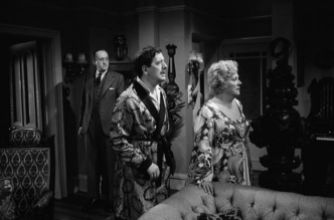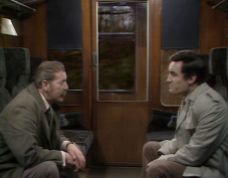
Story by Mordecai Roshwald, Adapted by J.B. Priestley
Directed by Rudolph Cartier
Level Seven is 4,500 feet beneath the Earth’s surface and it’s designed to be the last line of attack in the event of a nuclear war. Above them are six other levels – the first four are for civilians, the fifth is for the Government, scientists and the military whilst the sixth houses Defence Command.
X127 (Keith Buckley) is one of a select number of operatives charged with pushing the buttons that will release the missiles of death and destruction on the enemy. X117 (David Collings) works alongside him, but questions the reason for Level Seven’s existence. Whilst X117 runs foul of the authorities, X127 has met and married R747 (Michele Dotrice).
Eventually the order to attack is given and X127 and the new X117 (Sean Arnold) fire every last missile. The General (Anthony Bate) tells them that the war is over and they’ve won – but what price victory? Slowly it becomes apparent that everybody in the world is dead or dying and whilst it was predicted that Level Seven would be immune, that isn’t the case. There is no hope at all, so all they can do is to wait for the inevitable end.
Level 7 was a novel by Mordecai Roshwald which was published in 1959. Shortly after its publication it attracted the attention of J.B. Priestley who called it “‘the most powerful attack on the whole nuclear madness that any creative writer has made so far”. Priestley began work on a script for a proposed film, but for various reasons the film wasn’t made, so his screenplay was adapted for this episode of OOTU.
It goes without saying that it’s fascinating to have a writer of Priestley’s stature contributing to OOTU. Priestley’s abhorrence of nuclear weapons was well known (he was an active CND member) and in the play this is best given voice by a man and woman who venture up to the surface after the attack and report back to Level Seven what they’ve seen.
So listen to us, you people down there in the caves. There’s nothing to see here, but twisted metal and radio-active dust. Nothing, no birds are singing. No flowers growing, no trees, no fields. No men, no women, no children. Bare burnt earth, tortured metal, murderous dust. Nothing to see, nothing to hope for, nothing to love. The world is like a scorched ship, abandoned by the crew. It still revolves. There’s day and night, sun, moon and stars, but that’s all.
Keith Buckley and Michele Dotrice are both very good as the lovers who end up as the last people alive in Level Seven. Even better though, is David Collings as X117. Collings would make a habit of playing characters who have some flaw in their character which proves to be their undoing – and so it was here. X117 is eventually removed from his position due to insubordination and when we see him later he’s been reduced to working as a member of the cleaning staff and unable to remember X127 and the events that led to his “treatment”.
Anthony Bate gives a typically solid performance as the base commander, the General. The General has an unswerving belief in the right of his side in any war and the cracks only start to appear when he realises that everybody in Levels One – Six are dead and that maybe victory over a dead planet was no victory at all.
Level Seven was directed by the legendary Rudolph Cartier. Cartier had produced and directed Nigel Kneale’s Quatermass trilogy during the 1950’s and the two had also collaborated on the acclaimed adaptation of Nineteen Eighty Four in 1954. As with Quatermass, Cartier favoured music from The Planets Suite by Holst (the inclusion of excerpts from Mars, Bringer of War were particularly apt).
There are lengthy film sequences throughout the episode, probably to show the large number of people working in Level Seven (we tend to only see the full compliment of crew on film). The substantial amount of filming helps to give the story an extra sheen and given the involvement of Priestley/Cartier it’s possibly not surprising that the production team pulled out all the stops to make this as good as they possibly could.
Level Seven was a missing episode for decades and was only returned to the BBC relatively recently. We can be thankful that it was recovered – as it’s a powerful anti-war story dramatised by one of the greatest British playwrights of the 20th century.
Next Up – Tunnel Under The World

The Winners?

Michele Dotrice

Michele Dotrice & Keith Buckley

Keith Buckley

Anthony Bate

David Collings































































































































